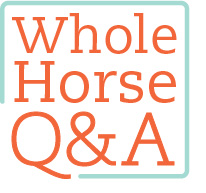Q I have part ownership in a mare that’s a wonderful show horse but has a bit of a bad attitude toward other horses and even people. We’re interested in breeding her, but wonder if that bad attitude might cause her to reject her own foal.

SHERI BARNOW, California
A Foal rejection, a potentially challenging problem, is defined as refusal to allow suckling and/or aggressive behavior toward the foal. Because the ingestion of antibodies in colostrum (first milk) is crucial to the health of a foal in the first few hours of life, a rejected foal is at risk of septicemia and even death.
To avoid interfering with natural processes, don’t disturb a mare and foal during the first 30 minutes after foaling, when the mare-foal bonding is most intense. The two important phases of maternal behavior are: 1) a general motivation to approach the foal and allow it to nurse, and 2) specific identification of the foal as the mare’s own. Don’t clean the stall or remove the fetal membranes immediately after foaling, plus avoid handling the foal when the mare appears nervous.
When foal rejection occurs, it can be divided into three grades of severity: 1) the mare accepts and licks the foal but doesn’t allow suckling; 2) the mare ignores the foal or moves away and will kick when the foal approaches; 3) the mare attacks the foal—obviously the most serious problem that usually requires separation of mare and foal for the safety of the foal (these mares should not be rebred).
The exact cause of foal rejection is unknown, though multiple factors may contribute, including maternal inexperience, hormonal imbalances, stress during foaling, and lack of contact with the foal. We can’t predict in advance, using a mare’s behavior toward people or adult horses, how she’ll behave as a mother. That said, when determining whether to breed a mare, we must take into account her overall temperament and character, considering that heavily in our decision.
Current treatments for foal rejection include chemical and physical restraint of the mare under a veterinarian’s guidance; this can work for mild rejections but is sometimes only a temporary solution leading to secondary behavioral problems. Behavior modification, by contrast, has been quite successful for grades 1 or 2 foal rejection. Strategies include negative reinforcement, positive reinforcement, gradual desensitization, and counter-conditioning.
Negative reinforcement is reinforcing the wanted behavior by removing pressure (a mildly aversive stimulus, such as a tight hold on the halter) immediately when the desired behavior is displayed (mare allows foal to approach). Positive reinforcement is offering desirable consequences (treats, grain) for the wanted behaviors (standing still, allowing the foal to approach and touch). Gradual desensitization involves a gentle working with the mare’s flank/udder to make her less reactive. Counter-conditioning is offering a positive stimulus (treats, petting) as the mare regards her foal, helping her make a positive association that changes her emotional response to the foal.

Behavior modification can often make it possible for a foal to nurse successfully within a short time. Moreover, desensitizing the flank/udder before foaling often helps reduce postpartum anxiety in the mare.
JEANNINE BERGER DVM, DACVB
Director of Behavior Resources
San Francisco SPCA






